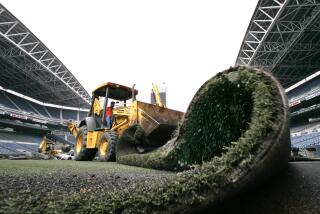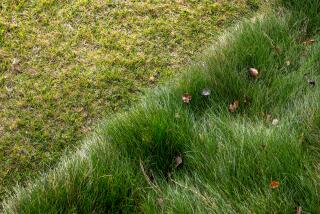An Ode to Men and Their Mowers
- Share via
In a world where tornadoes, earthquakes and landslides usually get the upper hand, the perfect lawn is a hallowed symbol of man’s dominion over nature.
That mower-as-God theory lies at the heart of Warren Schultz’s new book, “A Man’s Turf: The Perfect Lawn” (Clarkson Potter), which is both a campy look at the American male’s peculiar obsession with lawns and a richly illustrated lawn-care encyclopedia that, for example, devotes an entire chapter to the evolution of sprinklers and fertilizer spreaders.
“Grass is one of the few landscape elements . . . that we have some ability to improve or work with,” says Doug Fender, executive director of Turfgrass Producers International, a nonprofit sod-industry trade group. “There’s nothing like the escape of mowing the lawn. And when you’re done, you can see the results. There’s a personal satisfaction that’s relatively easy to achieve.”
In “A Man’s Turf,” Schultz covers everything from the history of turf grass in America to his childhood mowing memories to his theory that the lawn is “a Zen path through the suburbs.”
Who holds the world distance record for a riding mower? How many pounds of nitrogen-rich grass clippings end up in California landfills each year? The answers are sprinkled throughout a 200-page $35 publication that Fender describes as a “part coffee table, part workbench” book.
“There were just a lot of other things I wanted to say about the lawn. I wanted to write the kind of book that would cover it all,” says Schultz, an expert on natural lawn care whose 10 previous books include “The Chemical-Free Lawn” and “Shade Gardening.”
To that end, Schultz devotes significant space to the 1992 birth and subsequent growth of the U.S. Lawn Mower Racing Assn. Of particular interest is his description of the Dixie Chopper, the mother of all racing mowers. Powered by a 150-horsepower Chinook helicopter engine and capable of speeds up to 70 mph, it can mow an entire football field in 14 minutes.
“I’ve seen it on tape,” Schultz says. “It’s huge and looks dangerous. I wouldn’t want to strap myself to that thing.”
He also includes a fascinating account of how the O.M. Scott’s & Sons Co. conducted a decadeslong campaign to transform the public image of clover from a normal component of a healthy lawn into that of a useless weed that must be eradicated. (The reason? The company was marketing a herbicide that inadvertently killed clover along with other broad-leaf plants.)
Schultz concedes that lawn mowing holds the same attraction for many women as it does for men, but he makes no apologies for the book’s near-toxic testosterone level. Still, he believes mowing will remain a male-dominated pastime because of “the whole toy element of it. . . . We like the power and the noise.”
Schultz devotes the book’s final section to the future, noting the ongoing development of grass varieties that will require little fertilizer, no pesticides and fewer mowings. But with the advance of lawn science, Schultz says American boys are losing what for him was a cherished rite of passage into manhood.
“For me, when I go out to mow the lawn and get mesmerized by, frankly, the boredom of it, it brings back memories of lawns I mowed as a kid,” he says. “I just think there aren’t as many people having those memories these days. With the popularity of lawn services, it’s like we’re handing over those memories to surrogate sons.”
More to Read
Sign up for our Book Club newsletter
Get the latest news, events and more from the Los Angeles Times Book Club, and help us get L.A. reading and talking.
You may occasionally receive promotional content from the Los Angeles Times.










